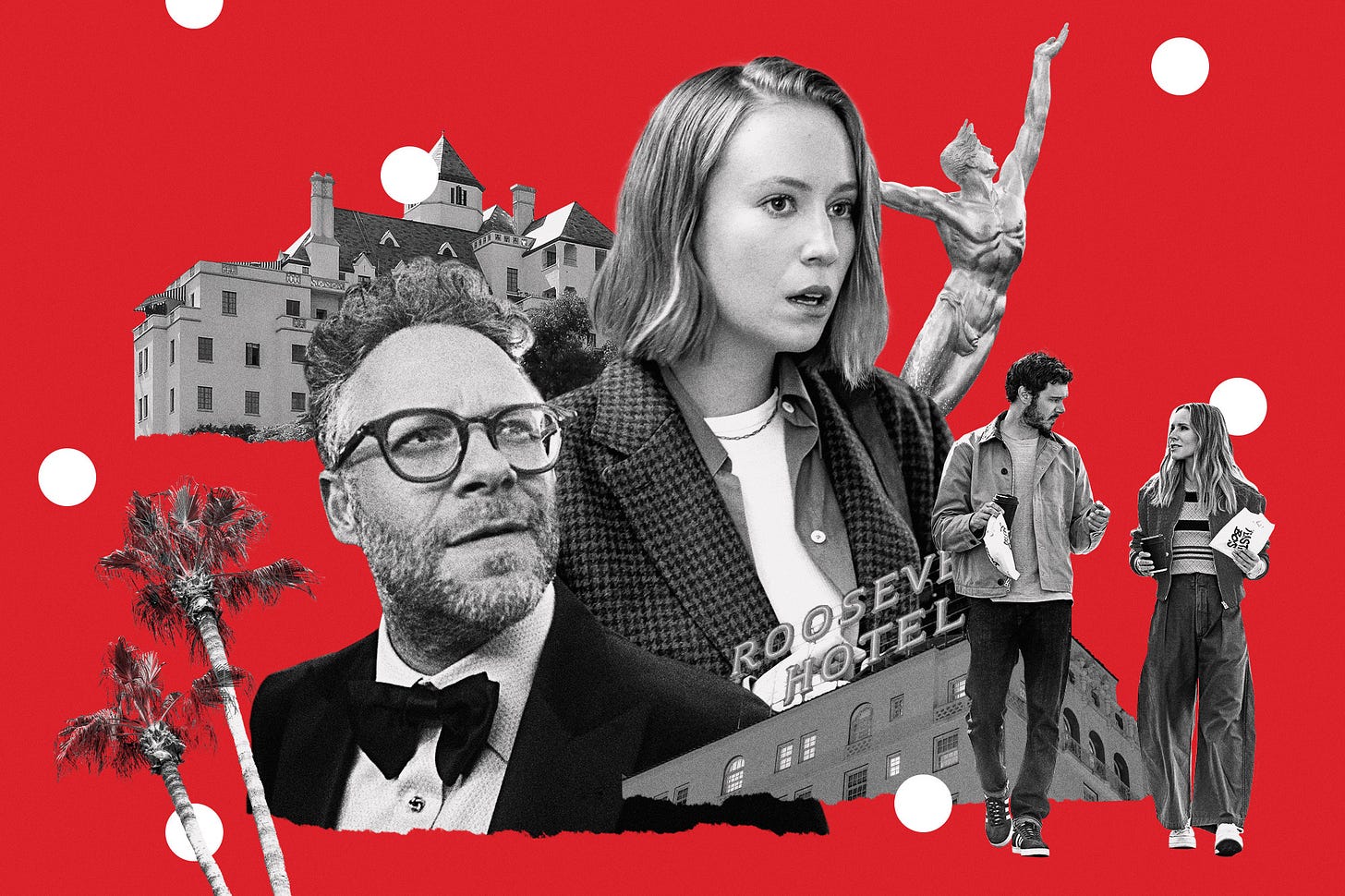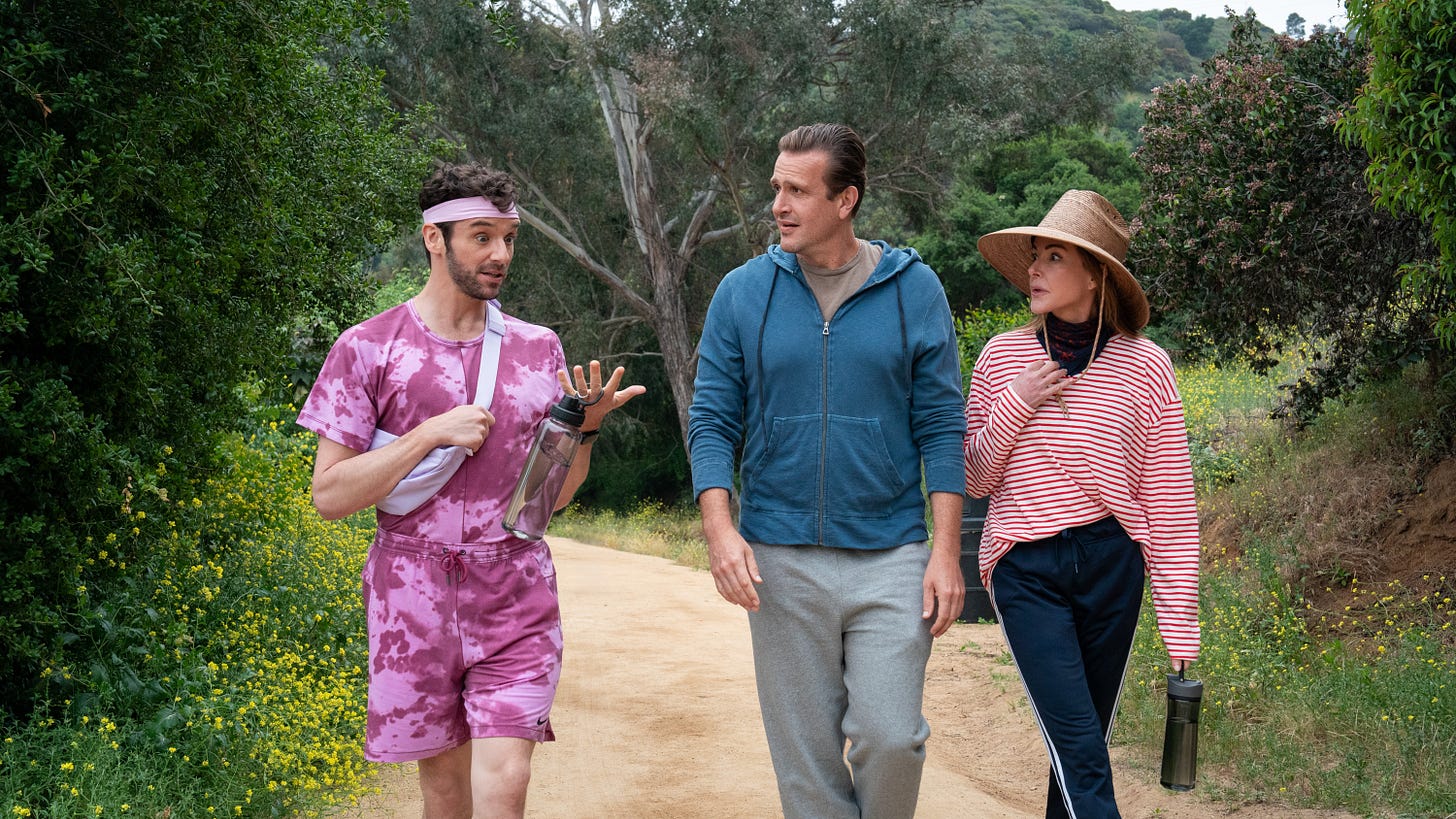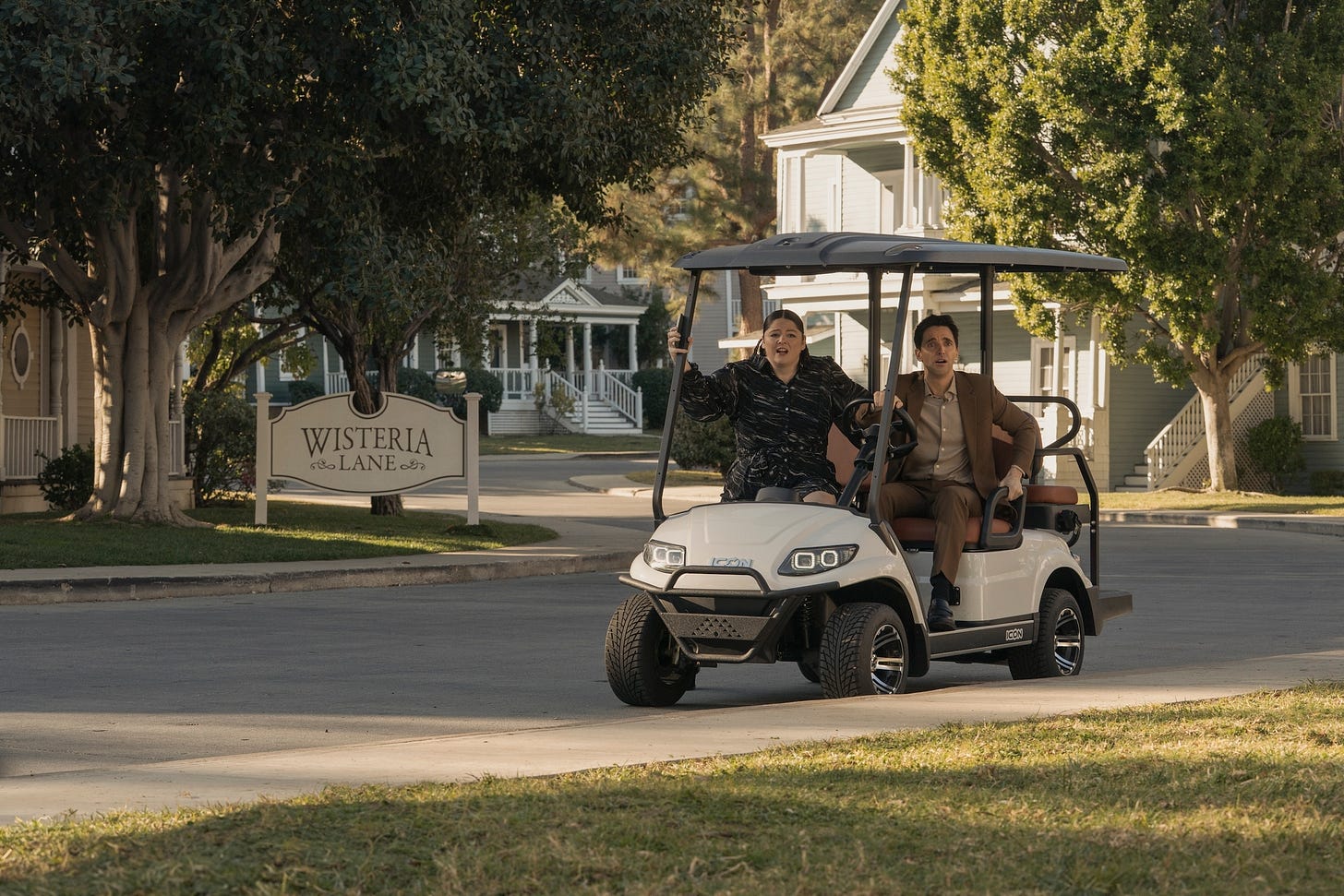They Love L.A.: The Shows That Brought Hollywood Back to the Small Screen
My 5-part look at TV's big trends of the year today examines Emmy hopefuls that let the City of Angels play itself once more

This week, with Emmy voting fully underway, I’m bringing you a five-part series looking at the overarching trends I’ve noticed among a lot of this year’s best television shows. TV is a deliberately broad, something-for-everyone medium. Still, there are undeniable connections that emerge each year, revealing what’s on the mind of Hollywood and what they believe the audience might be thinking about, too. In yesterday’s kickoff, I wrote about the micro-trend of shows featuring billionaires pulling the strings behind the scenes of a presidential administration — some of them deliberately topical, others totally coincidental. Today, we’ve got Los Angeles in a role the city would like to play a whole lot more often: itself.
Every time I’ve been to an Emmy season event this spring, no matter the subject at hand or the talent on stage, the same sentiment has inevitably gotten the biggest applause. “It’s amazing how many people have come up to me and said how cool it is to see L.A., and then on top of that, to have an L.A. crew,” Nobody Wants This star Justine Lupe told me during a panel hosted by Netflix, the comedy contender’s home platform.
Onstage at the DGA Theater a few weeks later, High Potential creator Drew Goddard told me, “I still love every block of this city, and it felt like we could use this city to its best potential.” The star and producer of the ABC hour-long, Kaitlin Olson, chimed in to add that before signing on, she told the network, “We’ll do it here, or get someone else.” The crowd, of course, went wild.
Boasting that you are made in L.A. has become a de rigueur element of Emmy campaigning this season, even for shows that aren’t set in the city, like ABC’s Abbott Elementary or Netflix’s The Residence. It’s not hard to see why. Still recovering from the wildfires, grappling with the military now parked downtown, and still facing production shortages and a shrinking job market, the city where the vast majority of the 25,000 Emmy voters live has been going through it.
My colleague Richard Rushfield frequently captures that unsettled feeling. As he told me recently, “The city and the industry have been through so much in the past years — reckonings, pandemic, fires, labor shutdowns, the jobs abandoning the city — this besides the city just becoming so fantastically expensive to live in that you have to drive an Uber on the side to earn the money just to try the hot new smash burger. People always felt they were lucky to be living here, but now it’s like… maybe the heavens are coming for us.”
But unless those primal forces of nature arrive before September, the Emmys will still march onward. Right now, it looks like voters will reward several shows filmed in Los Angeles—not bad as far as morale boosts go. The Pitt and Matlock are both set elsewhere but filmed in L.A., and their stars, Noah Wyle and Kathy Bates, seem very likely to be taking home the lead actor and actress trophies. How many L.A. crewmembers would cheer if their speeches included a nod to how great it is to make a show and drive home each night?
But today I’d like to shine a light on the shows that aren’t just from here but about here, set in Hollywood and not, all capturing aspects of the city that have felt especially worth preserving and celebrating lately. If 2025 is the year that the calls to bring production back to Los Angeles actually start being heeded, maybe these shows helped make that possible.
Another Perfect Day

“I believe that this city, at its core, is 50 cities in one,” Goddard told me at that event for High Potential, where he and Olson joined director Alethea Jones and showrunner Todd Harthan for a conversation about how they built the unconventional network procedural around Olson’s character, a janitor with a high IQ who starts collaborating with the LAPD. You can hear the full conversation on today’s episode of the Prestige Junkie podcast.
As Olson’s Morgan solves crimes across the city, High Potential has the chance to explore all kinds of corners of the city, from the iconic Union Station downtown to the Venice Beach waterfront. “We’re trying to use this show to show this city that we can do this, and we can do it responsibly and cost-effectively as well,” added Goddard, who also directed the show’s pilot. “And so far, so good.”
Even with so many L.A. soundstages still sitting empty, High Potential is part of a strong crop of shows that don’t just showcase the city, but the entirely non-Hollywood people who populate it. Netflix’s Running Point uses UCLA’s Health Training Center among its locations, and captures the executive offices and locker rooms of a fictionalized version of the L.A. Lakers. Apple TV’s Shrinking, filmed on the Warner Bros. lot as well as on location in Pasadena and Altadena, follows a group of Pasadena therapists who don’t just share the same sunny office, but spend a lot of time hanging out on a backyard deck overhung by California live oaks. As Shrinking co-star Michael Urie told me, it’s all a bit of an L.A. fantasy that none of them ever get stuck in traffic on their way to a hangout. “They must live really close to each other because they’re hanging out so much,” he said. “Sometimes you see some episodes take place in one day, and I’m like, ah, I did a lot that day.”
Nobody Wants This creator Erin Foster based the show on her own experiences as a lifelong Angeleno, and early on insisted that the series avoid soundstages in favor of capturing real locations in real L.A. neighborhoods. She now admits that some first-time showrunner naivete was at play. “In a lot of ways, I was wrong, because there are phenomenal sets that look very real and very natural,” she said in our conversation back in December. “But because I sort of forced this issue of location, we ended up being on a lot of streets, and we had an amazing location department that found a lot of interesting parts of town.”
Foster paid particular attention to which neighborhoods her characters would live in — Kristen Bell’s Joanne, for example, “felt like someone who would live in Beachwood or Los Feliz, but not Silver Lake, she’s not indie enough for that.”
L.A.’s varying neighborhoods were also a preoccupation for Mara Brock Akil, the creator of Netflix’s Forever, which updates Judy Blume’s classic young adult novel to follow two modern-day Black teenagers. The boy, played by Michael Cooper Jr., lives with his wealthy family in a hillside mansion, while the girl (Lovie Simone) lives in a modest apartment building south of the 10; both are filmed gorgeously. As Akil told me in a conversation alongside the show’s star Karen Pittman, “Every production meeting, every table read, on set, we would say, ‘Hey guys, we are telling a love story, both epic and intimate, within a love letter to Los Angeles.’”
Backlot Tours

For movies and TV shows about the actual business of Hollywood, that love letter has always been a little more complicated, going back to the days of Sunset Boulevard or the many tragic versions of A Star Is Born. This year, the two likeliest contenders for the top comedy Emmy are both set partly on studio backlots, each with their own mixed feelings about what’s supposed to be the most glamorous business in the world.
Following comedian Deborah Vance (Jean Smart) and her head writer Ava (Hannah Einbinder) as they launch a new late-night show from an L.A. soundstage, the recent fourth season of Hacks spends far more time highlighting the city where it’s always been filmed, even if it was often pretending to be Las Vegas. “There’s always been L.A. sprinkled throughout the show, but this season really does focus in on it,” said Einbinder, whose character moves into the Americana mall and has an emotional breakdown both in her show’s writer’s room and on the Santa Monica beach, among other season highlights. “I think it does accurately depict L.A. as we experience it.”
The season’s fourth episode, titled “I Love L.A.,” opens with a montage of the craftspeople working behind the scenes of Deborah’s show, many of whom, series co-creator and star Paul W. Downs told me, are part of the actual crew who work on Hacks. Downs and his co-creators Lucia Aniello and Jen Statsky had always planned to include that tribute to their L.A.-based crew in the episode, but when the wildfires broke out during production, “the universe helped focus what the show was,” Downs said. Securing a cameo from Randy Newman, performing the episode’s title song on Deborah’s show, really helped bring it home. “I Love L.A.” ends with a dedication to the first responders and victims of the wildfires alongside a photo of the 1915 Spanish Colonial Revival mansion that was featured on Hacks as Deborah’s Los Angeles home, which was burned down in the Eaton fire.
Both Deborah and Ava face the kinds of ritual humiliations and challenges that are familiar to anyone who has tried to get a show off the ground, from answering embarrassing press questions to pressure from the network brass. However, neither experience is quite as chaotic behind the scenes as we see on Apple TV’s The Studio, in which Seth Rogen plays a cinephile studio chief whose ideals about great movies are slowly eroded by the reality of making them, as well as his own ineptitude.
Whether wrecking a carefully planned shot on Sarah Polley’s set or throwing Martin Scorsese under the bus for the sake of hanging on to Kool-Aid IP, Rogen’s Matt Remick stumbles into every pitfall of the modern movie industry. But as the show’s director of photography, Adam Newport-Berra, told me, The Studio’s well-earned cynicism about the movie business is balanced out by an unflagging belief in its magic, as seen onscreen in basically every shot in the show.
“I think Seth and Evan have a very romantic view of Hollywood,” Newport-Berra said of Rogen and his co-creator and longtime collaborator, Evan Goldberg. “I think that they really love movies and they love Hollywood, and they want to honor that and also push it forward.”
Newport-Berra is responsible for the show’s many dazzling long-take sequences; you’ll read much more from him in tomorrow’s newsletter, where I’ll dig on several Emmy contenders that really lean into visual spectacle. Newport-Berra has a lot to say about the thrill of pulling off those single-take “oners,” but in the context of The Studio specifically, they work to capture a kind of movie magic that constantly feels on the brink of disappearing.
“It’s in a lot of ways a dying art, and it’s an art form that is really at odds with itself,” Newport-Berra said of Hollywood. There was a version of this show, he said, that could have captured something more realistic, the work of Hollywood that takes place in drab office buildings straight out of The Office. (The production offices seen in Hacks, for example, look a lot like that.) But on The Studio, he added, the goal was to conjure something beautiful and magical whenever possible.
No single show is enough to convince people to keep moving to Los Angeles and trying to be part of the business, but maybe it’s a start. As Newport-Berra put it, “I always wanted to create worlds that people wanted to be part of.”










